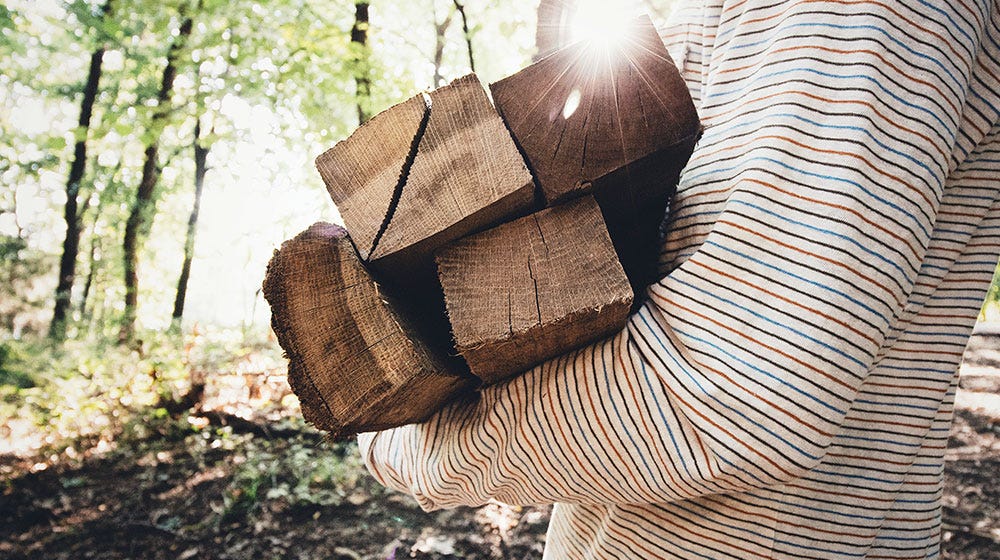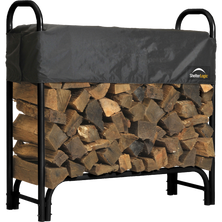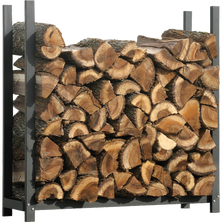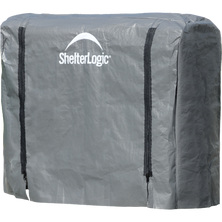Do the fall and winter make you excited about toasty fire pits and relaxing nights in front of a gently crackling fireplace? To make this happen, you need properly seasoned firewood that catches fire easily and burns evenly. After you obtain the right firewood, you need to store it in a place that will keep it dry, away from pests, and ready for use at any time.
This quick guide will discuss how to properly store firewood, where it should and shouldn’t be stored, why it needs to be covered, and how to properly season harvested wood. When you have the right storage methods and accessories, it's easy to keep a fire going and enjoy the colder seasons. Check out these dos and don'ts of how to store firewood.
How to Properly Store Firewood
Proper firewood storage requires a few conditions to be met. Overall, firewood should be kept on an elevated rack that is covered yet slightly ventilated to allow airflow. Also, firewood should be stored a short distance from the home from your building's exterior. This ensures that any pests don't enter your home. Here are the specifics about firewood storage and where to find the best solutions for your setup.
What Makes Firewood Racks Special?
When you need to store firewood in the best conditions, just any rack won't do. The unique nature of firewood racks keeps wood safely ventilated and protected from moisture and pests. While basic racks and shelves just hold wood, one made for firewood comes with a ventilated waterproof cover to keep the rain away. The waterproof polyester cover should be adjustable to cover your wood rack as it fluctuates in height.
Firewood racks are also high enough to keep all the wood off the ground. This ensures that moisture and pests from below don’t have easy access to your woodpile. Overall, this solution combines airflow and water protection, which is not typical of ordinary storage racks. It protects seasoned wood by keeping them dry and in optimal burning condition while protecting the wood from common wood-boring pests.
Where Should You Store Firewood?
Firewood racks should be placed at least three feet from home and never in the house; however, five feet is recommended. Placing wood too close to your house may invite pests into your home. Wood-boring pests especially like to tunnel from wood into a house, so stacking any wood against your home is a bad idea. This same rule applies to trees since many insects like to travel from trees to a firewood stack.
Placing your rack away from any structures or trees makes it easier to find a place where your wood rack can get proper ventilation. This also avoids any areas with poor drainage. Being near the edges of a house or adjacent to gutter runoff can spell trouble for your wood during a storm. However, when your wood is covered and safely stored in a spot where it can stay dry and elevated from the ground, you can be sure that it’s protected.
Avoid the temptation to store firewood in a garage, basement, or attic. Whenever wood is stored inside for a long period, insects and rodents are attracted to the stack. So, avoid any potential pest remediation fees by keeping wood stacks outdoors and away from your home. You should only bring in the required amount of wood for your indoor fire and not keep wood indefinitely inside your house.
Use a Foundation
It’s important to keep your wood dry from all directions. While you need a cover to keep the rain away, you should also protect your wood against moisture from the ground. There are several methods to keep the ground free from excess moisture. You may:
- Put a vapor barrier underneath your firewood rack.
- Place a few large patio stones under your firewood rack.
- Create a concrete slab foundation.
Any of these foundation options can be good deterrents to ground moisture. Vapor barriers are the cheapest and quickest option, while concrete slabs require more work with lasting results. However, no matter the price point, all methods are effective.
Use the Old Wood First
When you store wood, it’s important to use the oldest wood first. This rule is called “first-in, first-out.” When stacking wood, put the newest seasoned wood on the bottom and the oldest on top so that you can be sure that you’re using the right selections. This method mitigates pests, preventing infestations that typically happen in wood that has been sitting too long in a stack.
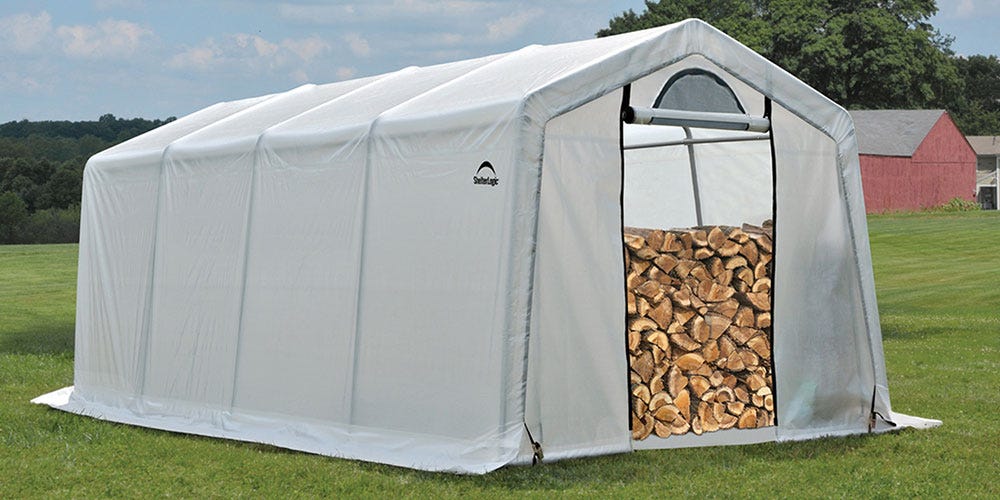

How to Dry Firewood Properly
When you decide to light a fire, it’s important not to burn wet wood. Burning wet wood increases the amount of creosote that accumulates in a fireplace and the amount of smoke. This makes both indoor and outdoor fires harder to maintain. However, properly seasoned or dried wood will be significantly cleaner and burn better too.
You can dry your firewood in a seasoning shed during the summer for use in the fall and winter. These structures are designed to dry wood more quickly than leaving them outside. Depending on how much wood you need, there are various shed sizes to meet your wood quota.
When to Get Wood?
It’s best to harvest wood in the late summer and early fall. Time it conveniently when you need to clear your property of some trees. You can also be helpful to a neighbor and take away their lumber after a tree project, which provides you with free wood and helps them save on the costs of clearing their property.
Be sure to transport any wood according to local regulations so that you comply. It’s also important to stick to seasoning local wood to avoid bringing non-native insects into your region.
How to Store Firewood Outside in Summer
If your goal is to create wood for efficient and long-lasting fires, you must invest in a seasoning shed. This structure will prepare raw wood to make it burn twice as fast compared to open-air drying. These sheds are unique to other storage buildings because they keep your wood away from the elements while allowing maximum airflow. Four components make a seasoning shed effective:
- A sturdy steel frame to keep a stable roof slope, keeping away rain.
- A translucent polyethylene cover to let in light and heat.
- A vapor barrier to block excess ground moisture.
- Cross ventilation design that aids in the drying process.
Because there is good ventilation and light drawn into the shed, these structures prevent mold and pest infestations. Use this place to prepare the wood and store any extras for a short time before you transfer them to a firewood rack.
Seasoning Shed Size Calculator
There are various seasoning sheds to accommodate your needs based on how much wood you want to store and your desired frequency of use.
- 5 x 3.5 x 5 ft: Holds up to a half cord of wood. This is ideal for people who occasionally enjoy fires.
- 10 x 10 x 8 ft: Holds up to three half cords of wood, guaranteed to store enough wood for a household that enjoys fires more than twice a week.
- 10 x 20 x 8 ft: This massive shed size can hold up to seven cords of wood—perfect for families who depend on a wood stove for heat and those who like to share!
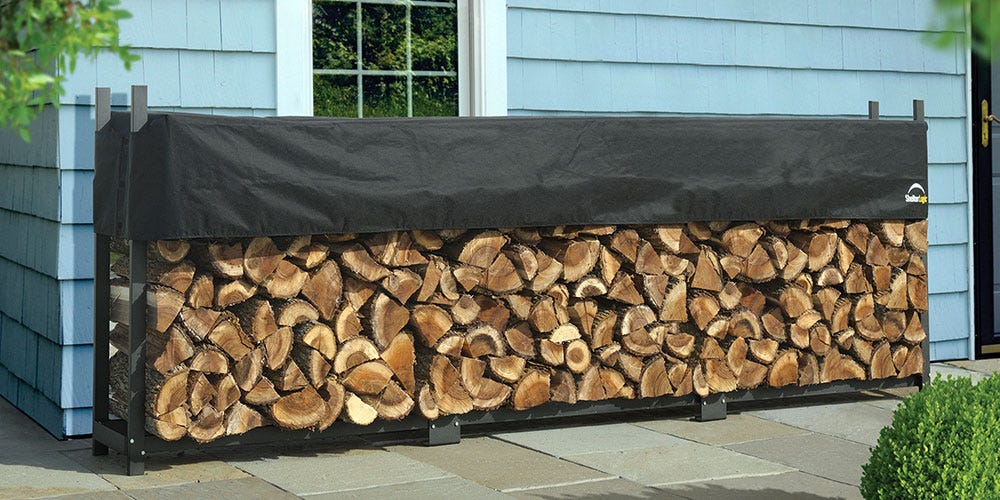

Hearth Products and Accessories
Want the best experience? Hearth products like rolling firewood carts, fireplace screens, log holders, toolsets for stoking and rearranging logs, and coal hods await. With the right tools, you can have a successful fire and have easy cleanups.
What Accessories Do You Need?
The best accessories for you are based on where you want your fire and how you plan to enjoy it. Do you prefer having an outdoor fire pit or an indoor fireplace? This helps you decide what to get. Unanimously, you need a toolset no matter where your fire is located. It’s also a given that you need an outdoor fire rack to keep seasoned wood nearby but not in your home. The rest depends on how you want to enjoy your fire.
Outdoor Fires: Furniture and More
If your firepit is outside, you may not need a single-day log holder unless you want logs close by. However, since you’re outside, you can simply get some logs from your firewood rack. If you want to get all the logs you need at once, roll some wood over with a firewood cart.
You should also invest in outdoor furniture such as fold-up chairs and side tables where you can have delightful conversations and snacks around the fire. Keep these items clean by folding them up afterward and putting them in a deck box. This is also a good place to store your fire pit accessories when they’re not in use.
Indoor Fires: Keep Your Comforts Close
When you want to stay in and enjoy your fire, you need a log holder to keep just a select amount of wood inside. This makes it possible to feed your fire without having to go outside in the cold for more wood. If you have a long trip from the fire rack to your log holder, get a firewood cart to make it a one-trip errand. Fireplace screens are also a must for indoor fires to block any “pops” from burning wood. Be sure to keep a fireplace tool kit nearby so you can readjust logs and stoke the flame to get it just right!
Find Firewood Storage Solutions for Outside and Inside
You can season and preserve properly dried wood to make fantastic fires for months when you have the right storage solutions for your firewood. Now that you know how to store firewood find high-quality firewood racks and seasoning sheds at ShelterLogic.

